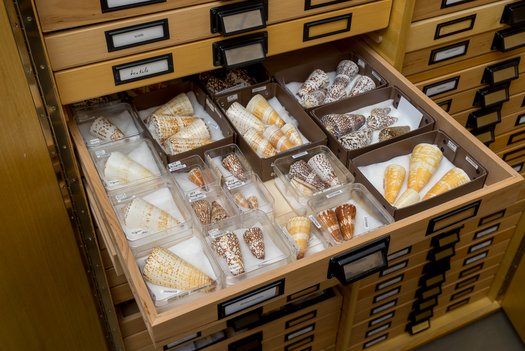Contact: Dr. Ira Richling
The mollusc collection at the SMNS comprises more than one million specimens in more than 130,000 lots. Exotic marine shells represent the oldest objects already listed in the catalogue of the physician Pasquay (Frankfurt a. M.) in 1777. The collection Clessin (German, Austrian and Hungarian molluscs, bought in 1903), the collection Zwiesele (bivalves from rivers, lakes and ponds of southern Germany and Switzerland, bought in 1925), and the collection Geyer (molluscs of the state Württemberg; bought in 1932) are especially worth mentioning among the historical parts. During World War II some parts of the collection were destroyed but the main portion survived undamaged and is available to scientists from all over the world.
In addition to the scientific revision of these old collections, new material is assembled during focused collection for current research projects. For example, land and freshwater molluscs are well suited to evaluate habitats because of their low mobility and often very special ecological requirements. Records of live snails and empty shells allow investigations of population dynamics and site fidelity.
Among the marine molluscs, the collections of tropical cone shells (Conidae, mainly collections Röckel and Da Motta, about 20,000 lots), olives (Olividae, coll. Greifeneder, nearly 3,000 lots), West African Volutes (genus Cymbium, coll. Stürmer), and Mediterranean molluscs including a substantial part of wet specimens and with special consideration of the 'Lessepsian' migration (coll. Enzenroß) are of world-wide importance. Continental molluscs of special significance encompass the collections of door snails of the Western Palaearctis (Clausiliidae, coll. H. Nordsieck, about 10,000 lots), European island faunas (coll. Rähle, Beckmann), slugs (coll. Rähle and genus Limax) and freshwater molluscs (coll. Meier-Brook).





